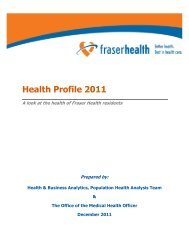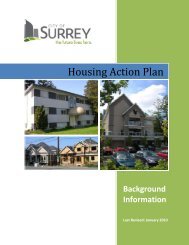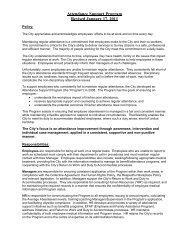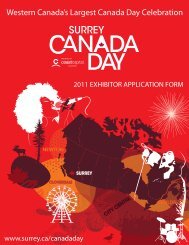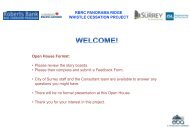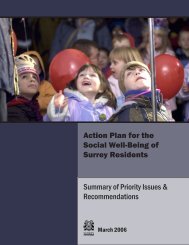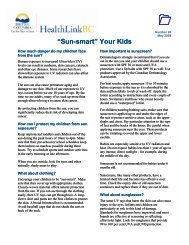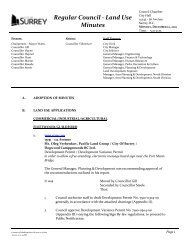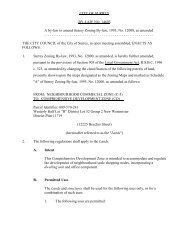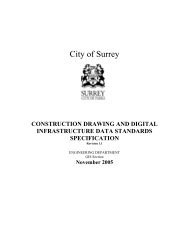Blackie Spit Park: Wildlife Habitat Enhancement Plan - City of Surrey
Blackie Spit Park: Wildlife Habitat Enhancement Plan - City of Surrey
Blackie Spit Park: Wildlife Habitat Enhancement Plan - City of Surrey
You also want an ePaper? Increase the reach of your titles
YUMPU automatically turns print PDFs into web optimized ePapers that Google loves.
MANAGEMENT<br />
UNIT<br />
3. Community<br />
Gardens<br />
4. Dunsmuir<br />
Old-field<br />
5. Dunsmuir<br />
Meadow<br />
6. Dyke &<br />
Ditches<br />
WILDLIFE/HABITAT<br />
GOALS<br />
Where desirable and<br />
practical, plant species<br />
with wildlife benefits (e.g.<br />
flowers for hummingbird)<br />
Grassland species <strong>of</strong><br />
small mammals and their<br />
predators (e.g., herons,<br />
raptors, coyotes), and<br />
grassland passerines<br />
(breeding savannah<br />
sparrows and other<br />
wintering sparrows).<br />
• Migratory and<br />
breeding grassland and<br />
field-edge passerines.<br />
• Small mammals and<br />
their predators.<br />
Dyke: Sparrows, finches,<br />
& butterflies<br />
Ditches: Aquatic insects<br />
and other invertebrates,<br />
swallows, flycatchers,<br />
waterfowl, and wetland<br />
birds (and amphibians if<br />
not too saline)<br />
7. Dyke Hedge Breeding and migrating<br />
passerines and<br />
woodpeckers<br />
HABITAT MANAGEMENT OBJECTIVES<br />
• Maintain as a community garden;<br />
• Work with community gardeners to ensure that<br />
composting and plant disposal methods are used that<br />
minimize the escape <strong>of</strong> non native plants into the<br />
surrounding areas;<br />
• Encourage gardeners to maintain a native deciduous<br />
shrub/small tree hedgerow along the north border.<br />
• Renovate fields, as necessary, to maintain the grass<br />
species mix and old-field structure necessary for the<br />
target and other associated wildlife species;<br />
• Mow fields, annually or as required, to maintain the<br />
desired grass height and to control undesired shrubs<br />
and blackberries (this applies especially to the north<br />
portion);<br />
• Remove invasive species (e.g. reed canarygrass<br />
(Phalaris arundinacea), blackberries, escaped garden<br />
plants);<br />
• Maintain a hedgerow along the west side and south <strong>of</strong><br />
MU 3;<br />
• Public viewing will continue to be from adjacent roads<br />
and dykes, with no access to the interior.<br />
• Renovate field centre and hay or rough cut annually;<br />
• Allow field edges to continue to grow as hedgerows<br />
with blackberries, salmonberry (Rubus spectabilis) and<br />
small trees within predefined boundaries.<br />
• Maintain wildlife flowers and low-growing grasses<br />
along both dyke sides;<br />
• Allow the natural occurrence <strong>of</strong> aquatic vegetation to<br />
the extent that it does not impede drainage or cause<br />
flooding;<br />
• In the north ditch, determine the reason for the shrub<br />
die-<strong>of</strong>f. Allow dead shrubs to remain for perches for<br />
swallows, flycatchers, and other birds. <strong>Plan</strong>t sparsely<br />
spaced, low-growing, slow-spreading shrubs above the<br />
waterline, if possible.<br />
• Maintain existing plant species and community<br />
structure (i.e. no trees over 8 m);<br />
• Manage access and/or vegetation so as to minimize<br />
disturbance to estuarine birds;<br />
• Create destination feature/low viewing structure/-<br />
benches at east end, overlooking estuary to north, to<br />
replace existing access onto Cannery <strong>Spit</strong> in MU 1.<br />
<strong>Blackie</strong> <strong>Spit</strong> <strong>Park</strong>: <strong>Wildlife</strong> <strong>Habitat</strong> <strong>Enhancement</strong> <strong>Plan</strong> – PART 1: Background and Summary 10



